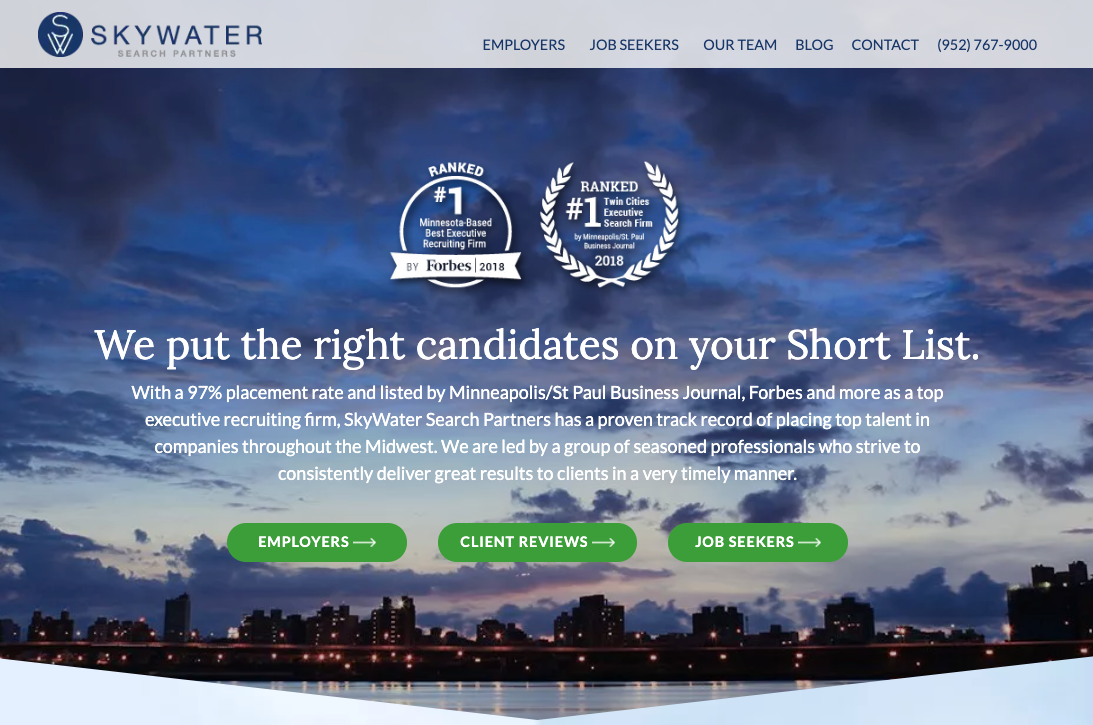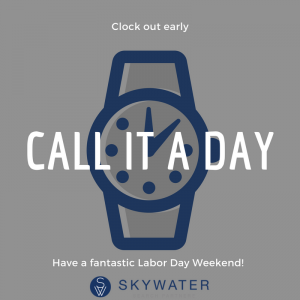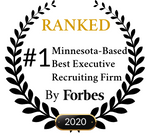Employers are under increasing pressure to find new ways to source the talent needed to meet business objectives. As specialists in both the tech and engineering sectors at SkyWater Search, we’ve observed three key trends which may create challenges for employers trying to connect with the qualified candidates their organization needs.
Adam Hoffarber

Recent Posts
Engineering & Technology: 3 Key Trends Employers Need To Know
American employees are disengaged and millions are looking for a new job. As a number of IT companies are beginning to discover, the sector isn’t immune. With low levels of unemployment and a scarcity of available talent, employers can’t afford to assume their top performers are satisfied in their work.
A New Whitepaper from SkyWater Search Partners:
Earlier this week the Minneapolis/St.Paul Business Journal announced their 2019 Best Place To Work award recipients. For the fifth year, SkyWater Search Partners has made the list. We are so humbled and honored to make the list again this year. Here are a few words about what this award means to us.
SkyWater Search Partners is delighted to announce the launch of our new website.
At the end of every interview, you will normally be given the opportunity to pose questions to the employer. If it is a fiercely contested vacancy, here’s your chance to edge ahead of the field. The responses you are given will also offer insight into whether or not a move to this company is in the best interests of your long-term career plan.
7 Habits of Wildly Successful Hiring Managers
Every hiring decision has long-lasting consequences, even when (especially when) the new hire doesn’t work out. That’s true in every market, in every industry, whatever the state of the economy.
Talk about pressure.
Now multiply that pressure by all the factors at play when you’re a small business owner in today’s economy…
The current employment market is a near-miracle of modern economics. But for many small business owners and managers, this “candidate’s market” has turned hiring into a competitive nightmare.
It's a war out there and, sometimes, in the heat of the hiring battle, it’s easy to make mistakes.
Like this one: have you ever come face-to-face with a candidate who appears to be unicorn-perfect on paper? Have you immediately thrown caution to the wind – and your best offer at said unicorn – out of sheer panic that the unicorn would be swept up by a competitor?
Big mistake.
Too often, the candidate with the perfect resume just isn’t the perfect fit for your organization. And most paper-perfect unicorns who get hired without proper vetting turn out to be new hire nightmares. And the smaller your workplace, the greater the pain of a bad hire.
So how can you vet and interview finalists to be sure that the one you hire is really the one for you?
I've worked with some of the country's most successful hiring managers and recruiters. And I've noticed something they all have in common:
They don't treat hiring like an isolated exercise.
They treat it like a core discipline, critical to their own success.
And they do that by following these 7 simple habits that you can follow, too.
1. Create job descriptions that are aspirational, motivating, and realistic.
Every job description you send out into the world should reflect your organizational brand – and your brand as a manager – in content, tone and core values. To successfully sell those brands to the talent you're trying to attract, include detail about the core responsibilities, tasks and deliverables but be sure you link those responsibilities to the success of the organization. By doing so, you show candidates they’ll be a valued contributor to your team. Use the job description to promote the very best things about working within your organization. Use words that shine a powerful light on the immediate benefits and the long term opportunities. And never use exaggeration or misleading statements. (Beyond being ethically wrong, a misleading job description will attract candidates who are guaranteed to be disappointed once they discover that the real job doesn’t match the bill of goods you sold them.)
2. Seek talent from organizations of similar size, with similar values.
Don’t limit your search to candidates within your own industry. The truth is, your next great hire is probably working quite successfully in a completely different industry.
Think about it: technical skills are trainable. Attitude, aptitude, character, work values, and work styles are not.
Most often, entrepreneurial people thrive in small, growing businesses – and they know that about themselves. If you happily wear many hats and expect your employees to do the same, don’t woo candidates who need the hierarchical structures and relative predictability of large corporations. Use language that highlights entrepreneurial realities like, “growth oriented,” “dynamic organization,” and “takes the ball and runs with it.” If you’re a small, growing company where everyone is expected to roll up their sleeves and pitch in when necessary, the candidates you really want will love it. The candidates you don’t, won’t.
3. Ask behavioral interview questions to identify core competencies and core values.
The smaller and more entrepreneurial your business, the more likely you’ll need a candidate who loves being a problem solver, is endlessly curious about how things work and how they can work even better, can remain positive and productive during periods of chaos, and is extremely goal oriented. Invest time in crafting questions that probe for a clear match between the realities of the job and the realities of the candidate. If you need someone who thrives on change, ask them about a time they’ve had to adapt their approach because of an unexpected twist in a project. If you need a team player who not only brings their A-game but brings out the best in others, ask about a time when they’ve helped their employer overcome a challenge. Then listen for responses that highlight the candidate’s own strengths while recognizing the contributions of others.
4. Expect flexibility and provide flexibility.
So, you’re seeking a super dynamic employee who is capable of adapting to challenges as they arise, without rigidly clinging to routines or old ways of doing things. Not surprisingly, the best candidates are seeking the same things from an employer. How do you stack up? Do you offer flexible work hours? Can employees work from home? Do you offer unlimited PTO? Maybe you’re not as competitive as you thought you were. Talk to an employment professional. Do the math on the costs and benefits, and figure out where you can improve.
5. Engage and nurture the current team.
There is no such thing as a “neutral hire.” Never. So never underestimate the impact your new hire will have on your existing team. Their continued excellent performance hinges largely on their good will about you as an employer. Before you even post a new position externally, consider the people who are already thriving in your organization. If they have the aptitude and the desire to take on bigger responsibilities, promote them. Then fill their old position with an outside hire, instead. Thoughtful, well planned internal promotions send a powerful message to everyone on the team about their value to you and your organization. Your reputation for promoting from within is one of the most powerful retention tools you'll ever have. When you do post a new position, tell your current employees first. Don’t seek permission but do make it clear that you need their support and you respect their perspectives. When they’re on board, the new hire’s on-boarding will go better.
6. Create test drive opportunities.
Interviews reveal a lot. But all the talk in the world can’t show you how anyone will really function in this job, with your team, at your company. The closer you can get to a relevant work sample, the better. Build a realistic test project into the early screening process. Or, when possible, involve your current team members in working with final candidates on a group project. Sometimes, even when you’re sold on a candidate, they might be on the fence about you. Instead of pressuring a candidate to accept or decline your offer, how about a six month contract? Trial periods, probationary hires, and short-term contracts give all parties a chance to try the gig on for size before committing. At the end of the contract, if it’s a fit, you seal the deal with a permanent offer. If it’s not, you both go your separate ways, with fewer hard feelings.
7. Never stop recruiting.
The greatest hiring managers and recruiters I know are always on the lookout for great talent. They never stop because, for them, recruiting is not a switch that can be turned on and off, based on job openings.
For these managers, recruiting is an everyday awareness of talent, the ability to recognize it, and a deeply ingrained habit of asking two basic questions:
“How could this person help my company grow?”
and
“How could I help this person leverage their abilities and grow?
Wherever you are, keep your eyes and ears open for standout talent. Even when you’re not actively trying to fill a position, offer to connect these individuals to people who might be. You’ll cultivate a loyal network of talented people who will reciprocate when you are hiring.
How to Answer the Question: What makes you better than your competition?
Without ever, ever trashing your competition
5 Retention Tactics I Learned From Our Employees
In a recent ADP article, writer Ellen Gregory dispels a few long-held myths about “generational differences” in today’s workforce. Most notably, she points to U.S. Department of Labor statistics from 1983 – 2016 (the most recent available) to suggest that “job hopping” among younger workers is not a new phenomenon. Millennials didn’t start this trend. In fact, today’s baby boomers jumped around from job to job at roughly the same frequency when they were the age of today’s millennial workers.
Jobs, Work, and the Pursuit of Something Bigger
What Labor Day Could Mean to All of Us

















